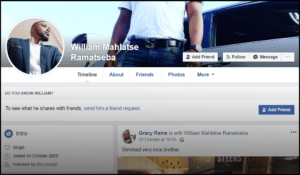Programmatic Advertising

As we’ve highlighted elsewhere on this site, disinformation websites monetise their traffic using various means, including cryptojacking and direct advertising.
During the course of News24’s investigation into disinformation websites, it quickly became apparent that the most prevalent way disinformation websites make money is through programmatic advertising. Except for one website, all of the disinformation sites had some form of programmatic advertising.
Most people would be able to relate to suddenly seeing ads for car insurance after searching for new vehicle, or how advertisements for wedding venues magically materialise after a couple’s engagement is announced on social media.
This is as a result of programmatic advertising, clusters of dynamic advertising banners that are tailored to each individual visitor.
Tracking cookies and history
Since websites can track your activity online, many sites use this information to build up a profile for each user. By analysing your internet browsing habits, a programmatic advertising platform attempts to predict and place adverts that a user would be more responsive to. If you’ve recently searched for an anniversary gift, for example, it assumes that you’ll also be responsive to a flower delivery service.
The programmatic advertising platform enters into an agreement with both the website owner and the advertiser, and acts as a form of a broker between the two:
- The website owner agrees to provide a portion of their website’s screenspace dedicated to the placement of ads by the programmatic platform. In return, they will be compensated by the programmatic platform whenever adverts are placed;
- The advertiser agrees to a specific rate with the programmatic platform, which determines how often and how visible the adverts will appear on the various websites that have opted in on the platform.
Old Mutual’s Tabby Tsengiwe summarised the workings in her response to enquiries sent by News24.
“If a user has visited a fake news website that has advertising inventory available, the retargeting algorithm is designed to follow the user.
Example:
I visit www.zando.com and I view a pair of red shoes. I do not purchase these shoes.
I visit www.news24.com and in the 300 x 250 ad unit alongside the article, the same pair of red shoes is displayed.
I visit www.fakenews.com and in the 300 x250 ad unit alongside the article, the same pair of red shoes is displayed.”
This is a very powerful way for a brand to reach an audience identified by algorithm as “susceptible” to the products being offered.
Loss of control
But when making use of a programmatic advertisement, a brand owner has little control over the exact website on which their brand will be advertised.
The exact placement of an advert will depend from one service to the next. Google Adsense, for example, allows advertisers to bid on “keywords”. If you are the successful bidder on a keyword, any website using Google Adsense that Google’s algorithms have identified as related to that keyword has a chance to show your advertisement. This could be a local news website, a sporting blog or a travel website, depending on which keywords were activated.
This process is out of the control of both the website owner and the advertiser, who rely on the programmatic platform to source, place and display the adverts.
This can have troublesome consequences. For example, during the height of the WMCLeaks campaign, programmatic adverts for the campaign were found on several websites overseas and locally. In one instance, Twitter user Brian Slater pointed out that an advert for WMCLeaks was displayed on News24’s app in September 2017.
#wmcleaks trolling @news24 on their own website! @RanjeniM pic.twitter.com/jfeXydS88F
— Brian Slater (@brianjslater) September 3, 2017
More often though, a brand might find its adverts being displayed on disinformation websites. In order to protect their brand, companies take steps to ensure that their advertisements are limited to websites that are aligned with their image. The prevents advertisements from cropping up on websites featuring pornography, torrent downloads or illegal services.
Defensive measures
Capitec Bank and their advertising partners, PHD Media, provided News24 with a comprehensive response regarding the measures they’ve taken to prevent the brand being associated with unwanted websites.
Charl Nel, head of communications for Capitec, explained at length how they categorised websites according to the kind of content they contain. These would then differentiate the advertising channels into “safe content areas” and “exclusionary categories”. The latter would include sites referencing illegal downloads, gambling, adult websites, as well as fake news sites, and they would be excluded from featuring their adverts.
The lists of excluded categories are updated monthly, and specifically includes fake news websites.
As a third layer of protection, Capitec uses external third party verification services to check the content and quality of its ads.
“As can be seen, we already take every precaution possible to ensure that our ads are shown in a brand-safe environment with three levels of protection.”
Ineffective measures
But despite these and other methods employed by the companies approached by News24 for comment, adverts were still displayed on several disinformation websites. This is mainly because of the way in which the adverts are published by the platform provider, in this case Google Adsense.
Thato Mntambo, Manager: Corporate Communications for Mercedes-Benz South Africa, told News24 that Google places the adverts, and not them.
“The adverts in question are not third-party placements (i.e. direct placements), but appear to be distributed via the Google Display Network (GDN). Simply put, GDN serves as a network of websites run by Google Ads, reaching over 90% of internet users worldwide. Google Ads are displayed wherever target audiences are, and serve as an effective marketing tool to target audiences to deliver better campaign performance.
“The unintended consequence of the pervasiveness of GDN is the difficulty to monitor the number of websites where our advertisements are displayed. We are conscious of the potential of incorrect placements and ameliorate the effects thereof through continuous monitoring of keywords and, in some cases, blacklisting keywords. We also negative match against sites displaying explicit, false, racist, sexist and/or abusive content. Since such sites are constantly proliferating, it is an ongoing task to monitor and update blacklisted sites, keywords, and negative matches, which we do on a regular basis across all our placements. We are also constantly investing in relevant tools to enhance the negative matching process and reduce the associated risk.”
Tanya Schreuder for Dentus Aegis, acting as the reputation managers for Coronation Fund Managers, echoed these statements.
“We know you are engaging directly with Google. This site was bought as part of the GDN network. As soon as concerns were raised around the credibility of content on the referred to fake news site, it was blacklisted/blocked and none of our clients will ever be on this site again. When we discovered the site, we immediately raised it with Google.
“Under no circumstances would the Dentsu Aegis Network, as custodians of our clients’ brands, consciously support sites which are illegal, undesirable or dubious in any form. We take brand safety incredibly seriously and, on behalf of all of our clients, we undertake every effort to ensure that any online inventory we deploy is legitimate and of a quality that is contextually suitable.”
Google’s Adsense was on of two programmatic platforms used by the disinformation websites investigated by News24. Google and MGID were both requested to provide comment on the fact that their platforms were helping to fund fake news websites.
Google responds
Making initial contact with Google’s South African office posed a challenge. The multibillion-dollar tech company’s regional office contact page only lists a business address in Johannesburg, with no phone numbers, or email addresses.
Contact was eventually made with a spokesperson for Google South Africa, who explained how they protect the brands that advertise using its platform.
“Our publisher policies govern where Google ads may be placed. We don’t comment on individual sites, but we enforce these policies vigorously and regularly review sites to ensure compliance. We also encourage people to let us know when they see sites that they have concerns about that may be in violation of our policies. More broadly, we’re deeply committed to ensuring quality news and information online – that’s why we’re constantly improving Search to connect users to results from authoritative sources, why we’re building a stronger future for news through the Google News Initiative and why we’re cutting off revenue to sites that violate our ad policies.”
Despite these measures, disinformation website HINNews.com used Google Adsense from as far back as May 2016. It was only removed from the Google ad network on September 21, 2018, after News24’s enquiries into the site.
MGID’s attempt
MGID’s provided a puzzling response. Initially, the company diverted our queries back to the website owner, despite the questions relating to their role in the placement of adverts.
“Unfortunately, we work only with publishers and advertisers. Your request should be sent to someone who owns the website (publishers). Thank you for understanding.”
After insisting that they provide us with specific answers with regards to their client’s adverts being placed on disinformation websites, MGID responded with a marketing email.
“We will be glad to monetise your audience with our native ad units. Please let us know which sites you are interested in monetising with us. Could you please let me know how many visitors per day you have on them?”




